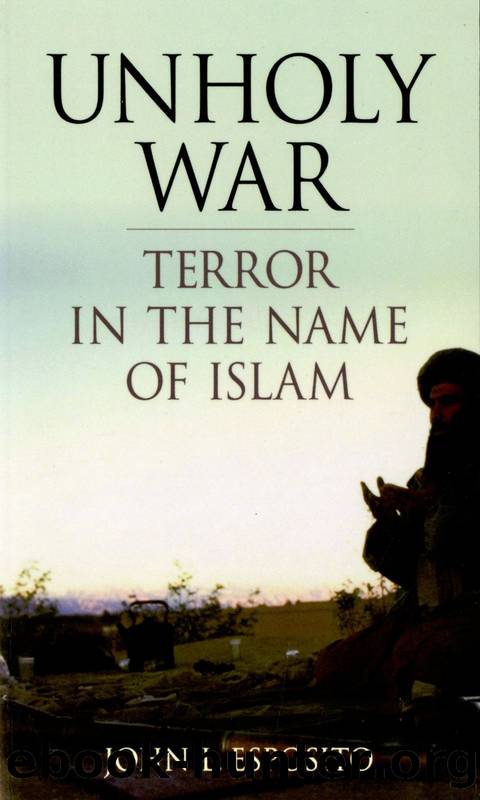Unholy War by Esposito John L.; Esposito John L.;

Author:Esposito, John L.; Esposito, John L.;
Language: eng
Format: epub
Publisher: Oxford University Press, Incorporated
Published: 2002-06-14T16:00:00+00:00
NATIONALIST MOVEMENT OF RESISTANCE OR TERRORIST ORGANIZATION?
Whatever the accomplishments of Hamas as a social and political movement, only its violent activities are known in the West. Members of Hamas participated in the everyday confrontations with Israeli forces during the intifada. The Qassem Brigade, a specialized military wing fully operational by 1992, engaged in wellplanned guerrilla warfare against Israeli military and police. Qassem’s members worked in small clandestine cells. Their identity was unknown to the majority of Hamas members and they functioned with relative autonomy.
When Israel and the United States condemned Hamas as a terrorist organization, Hamas leaders responded by saying that the use of violence is both legitimate resistance and retaliation that was restricted to political and military targets in the occupied territories. Their actions were a response to Israel’s occupation and its use of unrestrained violence and terror against Palestinians. This position changed dramatically after the 1993 Oslo Accords and in response to two events in Israel and the West Bank and Gaza.
On February 25, 1994, a Jewish settler named Baruch Goldstein walked into the Mosque of the Patriarch in Hebron, opened fire, and killed 29 Muslim worshippers during their Friday congregational prayer. In response, Hamas introduced a new type of warfare, the suicide bombers. Their attacks increased exponentially. Promising swift revenge for the Hebron massacre, the Qassem Brigade undertook five operations within Israel itself in Galilee, Jerusalem, and Tel Aviv. The most deadly took place on October 19, 1994, in the heart of Tel Aviv with the bombing of a bus that killed 23 and injured nearly 50 people. The Israeli assassination of Yahya Ayash, a suicide-bomb maker, resulted in another series of retaliatory suicide-bomb attacks. Peace negotiations in July 1997 were again disrupted when suicide bombers killed 13 and wounded more than 150 in a Jerusalem market.
What drives young Muslims to become suicide bombers? Many Palestinians have seen generations grow up in refugee camps or under Israeli occupation since the creation of Israel in 1948. Their sense of oppression and victimhood has been compounded as the promise of the Oslo Accords evaporated, like those of Camp David, under Yasser Arafat’s Palestinian National Authority. The visit of Ariel Sharon with Israeli security forces to the Temple Mt. sparked the second (Al-Aqsa) intifada in late September 2000. Growing up oppressed and under siege, facing a future with little hope, high unemployment, and endemic poverty can produce an anger and desire for revenge against those responsible. Just as among inner city youth in the United States, some of those young people lose all hope. For others, religion holds the answer. For a small minority, suicide bombing seems a proud and powerful response.
Completely out of their league militarily when compared to Israel, these militant Palestinians boast of their new and most effective deadly weapon. As student posters at universities in the West Bank and Gaza declare: “Israel has nuclear bombs, we have human bombs.”16 Suicide is forbidden in Islam, but militant Palestinians do not see this as suicide. It is self-sacrifice for the cause of Palestinian freedom.
Download
This site does not store any files on its server. We only index and link to content provided by other sites. Please contact the content providers to delete copyright contents if any and email us, we'll remove relevant links or contents immediately.
| Arms Control | Diplomacy |
| Security | Trades & Tariffs |
| Treaties | African |
| Asian | Australian & Oceanian |
| Canadian | Caribbean & Latin American |
| European | Middle Eastern |
| Russian & Former Soviet Union |
The Secret History by Donna Tartt(18846)
The Social Justice Warrior Handbook by Lisa De Pasquale(12141)
Thirteen Reasons Why by Jay Asher(8796)
This Is How You Lose Her by Junot Diaz(6794)
Weapons of Math Destruction by Cathy O'Neil(6146)
Zero to One by Peter Thiel(5686)
Beartown by Fredrik Backman(5599)
The Myth of the Strong Leader by Archie Brown(5425)
The Fire Next Time by James Baldwin(5249)
How Democracies Die by Steven Levitsky & Daniel Ziblatt(5128)
Promise Me, Dad by Joe Biden(5087)
Stone's Rules by Roger Stone(5026)
A Higher Loyalty: Truth, Lies, and Leadership by James Comey(4845)
100 Deadly Skills by Clint Emerson(4840)
Rise and Kill First by Ronen Bergman(4704)
Secrecy World by Jake Bernstein(4646)
The David Icke Guide to the Global Conspiracy (and how to end it) by David Icke(4625)
The Farm by Tom Rob Smith(4437)
The Doomsday Machine by Daniel Ellsberg(4416)
